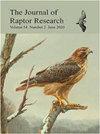Book Review: Vultures of the World: Essential Ecology and Conservation
IF 1.2
4区 生物学
Q2 ORNITHOLOGY
引用次数: 0
Abstract
Vultures of the World: Essential Ecology and Conservation. By Keith L. Bildstein. 2022. Cornell University Press, Comstock Publishing Associates, Ithaca, New York, USA. ISBN: 978-1501761614. Hardcover, $25.29 and Kindle, $12.99. Dr. Keith Bildstein’s latest book, Vultures of the World: Essential Ecology and Conservation, provides an engaging look at vultures and condors, seeking to help us understand this widely recognized but underappreciated avian group. Bildstein is known to many Journal of Raptor Research (JRR) readers as a past Raptor Research Foundation Vice-President (1999–2002) and member of the Board of Directors (1988–1997). Bildstein is also a former Sarkis Acopian Director of Conservation Science at Hawk Mountain Sanctuary, Kempton, Pennsylvania, USA. His new book reflects the culmination of nearly two decades of personal experience observing and studying vultures worldwide, focusing on migration and movement behavior, physiology, and ecology of migratory and nonmigratory vulture species. We (MAJ, EM, and JB) appreciate the opportunity to review this book on vultures and condors, as the three of us study these full-time obligate scavengers in the western hemisphere. In his three-page preface, Bildstein makes two critical points that the new generation of vulture biologists should consider. The first point: Bildstein has broadened his perspectives over the decades by interacting with other research biologists, and without those interactions, this book could not have been written. Consequently, this point emphasizes the importance of humility and having or developing social abilities necessary to discuss the subjects of study with your peers. The second point: two monumental monographs by Brown and Amadon (1968) and Mundy et al. (1992) have provided an effective model to describe the essential ecology of these full-time obligate scavengers, facilitating Bildstein’s work on vultures at a global scale. The takehome message here is that regardless of the age of the reference, older literature can provide critical insight into the current knowledge of the subject of study. Vultures of the World provides thoughtful explanations to simple questions such as ‘‘Why are vultures the only full-time obligate scavengers in the vertebrate group? What physical and behavioral adaptations have evolved that allow them to inhabit a diverse set of habitats? How do vultures find and feast on rotting flesh?’’ Moreover, it provides helpful background on New World (family Cathartidae) and Old World (family Accipitridae) vultures. JRR readers may remember these terms refer only to the current species distributions and not their geographical origins, which is an important distinction, as Old World vultures may have evolved in the New World, and those we call New World vultures most likely evolved in the Old World. The scavenging habits of these two families are thought to have evolved independently, leading to adaptations such as large bodies, broad wings, powerful beaks, and featherless heads, representing one of the best examples in natural history of convergent evolution. Vultures of the World opens with a personal and well written general introduction on the origins and evolutions of vultures, followed by seven chapters. The introductory section assesses evolutionary processes that have led to the global diversity of scavenging raptors, along with a framework for书评:世界秃鹫:基本生态学和保护
世界秃鹫:基本生态学与保护。Keith L. Bildstein, 2022。康奈尔大学出版社,康斯托克出版协会,美国纽约州伊萨卡。ISBN: 978 - 1501761614。精装版25.29美元,Kindle版12.99美元。基思·比尔德斯坦博士的最新著作《世界秃鹫:基本生态与保护》,对秃鹫和秃鹰进行了引人入胜的观察,试图帮助我们了解这一被广泛认可但未得到充分重视的鸟类群体。Bildstein是《猛禽研究杂志》(JRR)的读者所熟知的,他曾担任猛禽研究基金会副主席(1999-2002)和董事会成员(1988-1997)。Bildstein也是美国宾夕法尼亚州肯普顿霍克山保护区的前Sarkis Acopian保护科学主任。他的新书反映了近二十年来在世界范围内观察和研究秃鹫的个人经验的高潮,重点是迁徙和运动行为,迁徙和非迁徙秃鹫物种的生理学和生态学。我们(MAJ, EM和JB)很高兴有机会回顾这本关于秃鹫和秃鹫的书,因为我们三个人在西半球研究这些全职的义务食腐动物。在他长达三页的序言中,Bildstein提出了新一代秃鹫生物学家应该考虑的两个关键点。第一点:几十年来,比尔德斯坦通过与其他从事研究的生物学家互动,拓宽了自己的视野,没有这些互动,就不可能写出这本书。因此,这一点强调了谦逊和拥有或发展与同龄人讨论学习主题所必需的社交能力的重要性。第二点:Brown和Amadon(1968)以及Mundy等人(1992)的两本重要的专著提供了一个有效的模型来描述这些全职义务食腐动物的基本生态,促进了Bildstein在全球范围内对秃鹫的研究。这里的关键信息是,无论参考文献的年龄如何,旧文献都可以为研究主题的当前知识提供关键的见解。《世界秃鹫》对一些简单的问题提供了深思熟虑的解释,比如“为什么秃鹫是脊椎动物群体中唯一的全职义务食腐动物?”它们进化出了什么样的身体和行为适应能力,使它们能够栖息在各种各样的栖息地?秃鹫是如何找到并享用腐肉的?此外,它还提供了有关新大陆(秃鹰科)和旧大陆(秃鹰科)秃鹫的有益背景。JRR的读者可能记得,这些术语只指当前的物种分布,而不是它们的地理起源,这是一个重要的区别,因为旧大陆秃鹫可能是在新世界进化的,而那些我们称之为新世界秃鹫的很可能是在旧大陆进化的。这两个家族的食腐习惯被认为是独立进化的,导致了诸如大身体、宽翅膀、有力的喙和无羽毛的头部等适应,这是自然史上趋同进化的最好例子之一。《世界上的秃鹫》以一篇个人的、写得很好的关于秃鹫的起源和演变的概述开篇,接着是七个章节。引言部分评估了导致食腐迅猛龙全球多样性的进化过程,以及一个框架
本文章由计算机程序翻译,如有差异,请以英文原文为准。
求助全文
约1分钟内获得全文
求助全文
来源期刊

Journal of Raptor Research
生物-鸟类学
CiteScore
2.30
自引率
17.60%
发文量
61
审稿时长
>12 weeks
期刊介绍:
The Journal of Raptor Research (JRR) is an international scientific journal dedicated entirely to the dissemination of information about birds of prey. Established in 1967, JRR has published peer-reviewed research on raptor ecology, behavior, life history, conservation, and techniques. JRR is available quarterly to members in electronic and paper format.
 求助内容:
求助内容: 应助结果提醒方式:
应助结果提醒方式:


